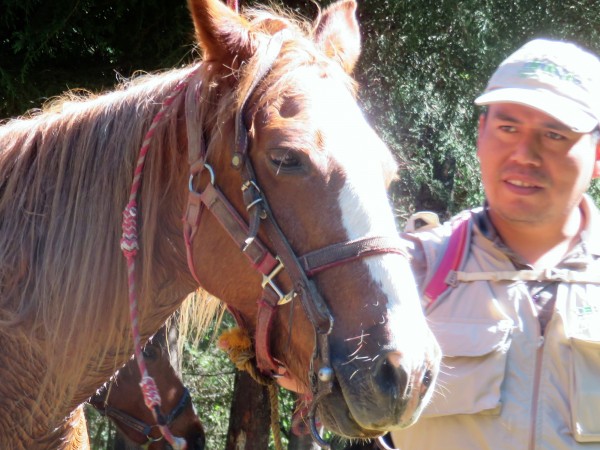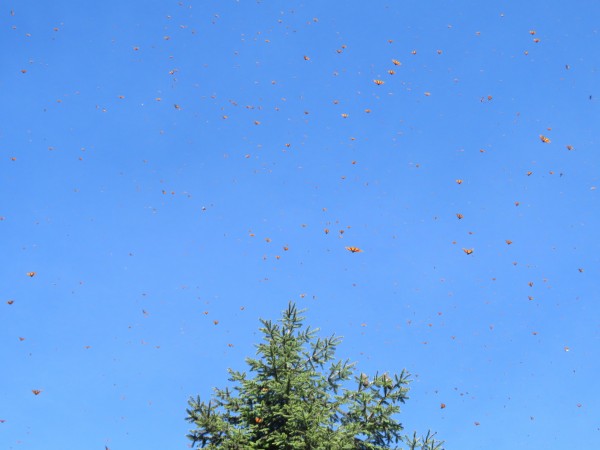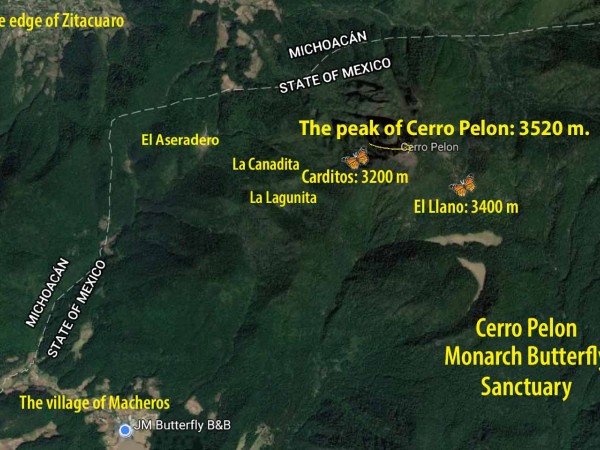Forming a Colony at Cerro Pelon
By Ellen Sharp
Pato Moreno is a lucky man; he gets to walk around the beautiful boreal forest of Cerro Pelón five days a week, tracking and protecting monarch butterflies for a living. He started working as a forest ranger for CEPANAF, the state park system of the State of Mexico, in the fall of 2014. This is his fourth season watching migrating monarchs select their roosts. Recently he was joined in these efforts by three arborists employed by our non-profit, Butterflies & Their People, a project made possible by a partnership with the Monarch Butterfly Fund. The accompanying images were taken by Pato and the arborists with the project’s camera.
The monarchs like to switch things up on Cerro Pelón; where they will form their roosts is anybody’s guess at the beginning of each season. In 2014-15, they roosted in an area called Carditos. The following year they chose an area above El Llano de Tres Gobernadores. Last season they started out in La Cañadita above La Lagunita before descending to trees above a meadow called El Aseradero (AKA Las Canoas). Trying to figure out where they’ll rest this season is keeping Pato and the arborists on their feet.
Ranger Pato’s Butterfly Diary: Searching for the Colony
Translated from Spanish by Ellen Sharp
November 1, 2017
The first of November we saw a lot of monarchs flying way up high, fluttering around the fir trees. The weather was cloudy and chilly and we left work late without seeing any signs of a colony.
November 2, 2017
The next day it was cold again. A little after 2 pm we saw the monarchs dispersing en masse like they always do before a storm. At 2:30 pm the sky broke open. We took shelter in a little shack we built for ourselves in a clearing in Carditos. There had been such a huge quantity of butterflies flying about that I thought for sure we would find a colony when the rain passed, but no such luck.
November 3, 2017
We hiked up to the higher altitude areas of the mountain above El Llano to look for monarchs. Finally, we encountered a dozen trees dusted with butterflies at 3,400 m. This area has taller trees that are between 40 and 70 years old. The clusters on them lacked the density of a true colony; it looked more like a temporary overnight roost. This is only the second time in memory that we’ve seen monarchs roosting at this high an altitude; 3,000 seems to be the average height of their roosts. But they started off this high at the beginning of the 2015-16 season too. My dad, Melquiades, who had this job before I did, tells me that he never saw them up this high during the 35 years he worked as a forest ranger. That day we kept going to the very top of Cerro Pelón, where we were greeted by the sight of thousands of them, flying in circles in the sky way above where we stood on top of the 3,520-m. peak. It was a beautiful sight.
November 4, 2017
The next day was sunny and clear. We hiked back through the same area, cutting through El Llano de Tres Gobernadores around 11 am before we ascended Cerro Pelón. We saw some clustered in the trees, but once again most of them were in the sky, flying in circles. In the afternoon we descended to Carditos, another one of their preferred perches. At 4 pm we observed roosts forming in five trees. There were still lots of them fluttering about, filling the air, still undecided about where to spend the night, when we started heading down the mountain.
November 5, 2017
By this point in the week we were feeling pretty exhausted from all this hiking, but we went back to the first place where we had seen the first clusters above El Llano anyway, and there it was-- a colony! More than 15 trees completely full of butterflies. It was around 11 am, and we kept going to the peak of Cerro Pelón, where once again we saw thousands of monarchs circling overhead, trying to decide where to land. Meanwhile, when we checked farther down the mountain later that afternoon, the smaller colony of five trees in Carditos had filled out with much denser monarch clusters.
It was an exciting week following the monarchs on Cerro Pelón. We’re wondering if they’ll stay in these two sites they’ve just established for the rest of the season. Or will these two proto-colonies end up merging, as they have in years past. Or move to a completely different spot. The roadways down below in the valley are filled with butterflies, and they’re still arriving on Cerro Pelon, which opens to visitors on November 18th. I’ll keep you posted on what these new arrivals decide to do.





